Skin and Scalp Health Benefits of a Specific Botanical Extract Blend: Results from a Double-Blind Placebo-Controlled Study in Urban Outdoor Workers
Abstract
1. Introduction
2. Materials and Methods
2.1. Study Design and Ethics Statement
2.2. Subjects
2.3. Ingredient Information
2.4. Intervention
2.5. Randomization and Masking
2.6. Primary, Secondary Objectives and Outcome Measures
2.7. Sample Size
2.8. Safety
2.9. Results Interpretation and Statistical Methods
3. Results
3.1. Participants and Product Tolerability
3.2. Effects on Facial Skin Conditions
3.2.1. Antioxidant Capacity of the Skin: FRAP Analysis
3.2.2. Skin Moisturization
3.2.3. Transepidermal Water Loss (TEWL)
3.2.4. Wrinkle Depth
3.2.5. Skin Elasticity
- Skin distensibility, measured as R0 (mm), significantly decreased in the group that consumed the active product, suggesting an increase in skin firmness. The decrease of skin distensibility was as follows: 4.7%, 7.1%, and 9.4% after 28, 56, and 84 days of product consumption (p < 0.0001 vs. T0 at all the checkpoints). A smaller decrease of 2.6% (p = 0.0013) and 4.6% (p < 0.0001) was also observed in the placebo group after 56 and 84 days, respectively. The variation between the active and placebo groups was statistically significant at all the checkpoints (p = 0.0004 at T28, 0.0005 at T56 and p = 0.0002 at T84)
- The gross elasticity of the skin, including viscous deformation, R2 parameter, was significantly increased in the ZP dietary supplement group. In the ZP treatment arm, the skin gross elasticity increased by 5.5%, 7.1%, and 9.4%, after 28, 56, and 84 days of product intake (p < 0.0001 vs. T0). A minor decrease of 1.6% (p = 0.0002) and 3.2% (p < 0.0001) was also observed in the placebo group after 56 and 84 days, respectively, while no significant change was observed in the placebo group. The variation between the active and placebo test product was statistically significant at all the checkpoints (p = 0.002 at T28, 0.006 at T56, and p = 0.0004 at T84)
- Net elasticity, not including viscous deformation, R5 parameter, significantly increased in the ZP group. Increased R5 may suggest reduced skin ageing. In the active treatment arm, skin net elasticity increased by 5.3%, 6.8%, and 9%, after 28, 56, and 84 days of product intake, respectively (p < 0.0001 vs. T0 at all the checkpoints). Minor improvements were observed in the placebo group after 56 days (2.5%, p = 0.012) and 84 days (3.1%, p = 0.013). The variation between the active and placebo test product was statistically significant at all the checkpoints (p = 0.0004 at T28, p = 0.025 at T56, and p = 0.013 at T84)
3.2.6. Effects on Radiance and Skin Colour
- Intensity of Dark Spots: Individual Typology Angle (ITA°)
- Skin Radiance, Gloss Value
3.2.7. Skin Oiliness
3.3. Effects on Scalp Conditions
3.3.1. Scalp Moisturization
3.3.2. Scalp TEWL
3.3.3. Scalp Oiliness
3.3.4. Scalp Appearance
3.4. Self-Assessment Questionnaire
4. Discussion
5. Conclusions
Supplementary Materials
Author Contributions
Funding
Institutional Review Board Statement
Informed Consent Statement
Data Availability Statement
Acknowledgments
Conflicts of Interest
References
- Air Pollution. Available online: https://www.who.int/health-topics/air-pollution (accessed on 18 August 2023).
- Boogaard, H.; Patton, A.P.; Atkinson, R.W.; Brook, J.R.; Chang, H.H.; Crouse, D.L.; Fussell, J.C.; Hoek, G.; Hoffmann, B.; Kappeler, R.; et al. Long-Term Exposure to Traffic-Related Air Pollution and Selected Health Outcomes: A Systematic Review and Meta-Analysis. Environ. Int. 2022, 164, 107262. [Google Scholar] [CrossRef]
- Lefebvre, M.-A.; Pham, D.-M.; Boussouira, B.; Bernard, D.; Camus, C.; Nguyen, Q.-L. Evaluation of the Impact of Urban Pollution on the Quality of Skin: A Multicentre Study in Mexico. Int. J. Cosmet. Sci. 2015, 37, 329–338. [Google Scholar] [CrossRef] [PubMed]
- Mancebo, S.E.; Wang, S.Q. Recognizing the Impact of Ambient Air Pollution on Skin Health. J. Eur. Acad. Dermatol. Venereol. JEADV 2015, 29, 2326–2332. [Google Scholar] [CrossRef] [PubMed]
- Fussell, J.C.; Kelly, F.J. Oxidative Contribution of Air Pollution to Extrinsic Skin Ageing. Free Radic. Biol. Med. 2020, 151, 111–122. [Google Scholar] [CrossRef] [PubMed]
- Rajput, R. Understanding Hair Loss Due to Air Pollution and the Approach to Management. Hair Ther. Transplant. 2015, 5, 2. [Google Scholar] [CrossRef]
- Cotovio, J.; Onno, L.; Justine, P.; Lamure, S.; Catroux, P. Generation of Oxidative Stress in Human Cutaneous Models Following in Vitro Ozone Exposure. Toxicol. In Vitro 2001, 15, 357–362. [Google Scholar] [CrossRef]
- Trüeb, R.M. The Impact of Oxidative Stress on Hair. Int. J. Cosmet. Sci. 2015, 37, 25–30. [Google Scholar] [CrossRef] [PubMed]
- Fadadu, R.P.; Abuabara, K.; Balmes, J.R.; Hanifin, J.M.; Wei, M.L. Air Pollution and Atopic Dermatitis, from Molecular Mechanisms to Population-Level Evidence: A Review. Int. J. Environ. Res. Public Health 2023, 20, 2526. [Google Scholar] [CrossRef] [PubMed]
- Lowe, M.E.; Akhtari, F.S.; Potter, T.A.; Fargo, D.C.; Schmitt, C.P.; Schurman, S.H.; Eccles, K.M.; Motsinger-Reif, A.; Hall, J.E.; Messier, K.P. The Skin Is No Barrier to Mixtures: Air Pollutant Mixtures and Reported Psoriasis or Eczema in the Personalized Environment and Genes Study (PEGS). J. Expo. Sci. Environ. Epidemiol. 2023, 33, 474–481. [Google Scholar] [CrossRef] [PubMed]
- Wu, J.; Chen, H.; Yang, R.; Yu, H.; Shang, S.; Hu, Y. Short-Term Exposure to Ambient Fine Particulate Matter and Psoriasis: A Time-Series Analysis in Beijing, China. Front. Public Health 2022, 10, 1015197. [Google Scholar] [CrossRef]
- El Haddad, C.; Gerbaka, N.-E.; Hallit, S.; Tabet, C. Association between Exposure to Ambient Air Pollution and Occurrence of Inflammatory Acne in the Adult Population. BMC Public Health 2021, 21, 1664. [Google Scholar] [CrossRef] [PubMed]
- Krutmann, J.; Moyal, D.; Liu, W.; Kandahari, S.; Lee, G.-S.; Nopadon, N.; Xiang, L.F.; Seité, S. Pollution and Acne: Is There a Link? Clin. Cosmet. Investig. Dermatol. 2017, 10, 199–204. [Google Scholar] [CrossRef] [PubMed]
- Kim, K.E.; Cho, D.; Park, H.J. Air Pollution and Skin Diseases: Adverse Effects of Airborne Particulate Matter on Various Skin Diseases. Life Sci. 2016, 152, 126–134. [Google Scholar] [CrossRef] [PubMed]
- Schikowski, T.; Hüls, A. Air Pollution and Skin Aging. Curr. Environ. Health Rep. 2020, 7, 58–64. [Google Scholar] [CrossRef] [PubMed]
- Roberts, W.E. Pollution as a Risk Factor for the Development of Melasma and Other Skin Disorders of Facial Hyperpigmentation—Is There a Case to Be Made? J. Drugs Dermatol. JDD 2015, 14, 337–341. [Google Scholar] [PubMed]
- Grether-Beck, S.; Felsner, I.; Brenden, H.; Marini, A.; Jaenicke, T.; Aue, N.; Welss, T.; Uthe, I.; Krutmann, J. Air Pollution-induced Tanning of Human Skin. Br. J. Dermatol. 2021, 185, 1026–1034. [Google Scholar] [CrossRef] [PubMed]
- Baudouin, C.; Charveron, M.; Tarroux, R.; Gall, Y. Environmental Pollutants and Skin Cancer. Cell Biol. Toxicol. 2002, 18, 341–348. [Google Scholar] [CrossRef] [PubMed]
- Siddens, L.K.; Larkin, A.; Krueger, S.K.; Bradfield, C.A.; Waters, K.M.; Tilton, S.C.; Pereira, C.B.; Löhr, C.V.; Arlt, V.M.; Phillips, D.H.; et al. Polycyclic Aromatic Hydrocarbons as Skin Carcinogens: Comparison of Benzo[a]Pyrene, Dibenzo[Def,p]Chrysene and Three Environmental Mixtures in the FVB/N Mouse. Toxicol. Appl. Pharmacol. 2012, 264, 377–386. [Google Scholar] [CrossRef] [PubMed]
- Burke, K.E. Skin Cancer Induced by Pollution-Mediated ROS. In Handbook of Oxidative Stress in Cancer: Mechanistic Aspects; Chakraborti, S., Ray, B.K., Roychowdhury, S., Eds.; Springer: Singapore, 2020; pp. 1–22. [Google Scholar] [CrossRef]
- Vierkötter, A.; Schikowski, T.; Ranft, U.; Sugiri, D.; Matsui, M.; Krämer, U.; Krutmann, J. Airborne Particle Exposure and Extrinsic Skin Aging. J. Investig. Dermatol. 2010, 130, 2719–2726. [Google Scholar] [CrossRef] [PubMed]
- Kwack, M.H.; Ha, N.G.; Lee, W.J. Effects of <10-Μm Particulate Matter on Cultured Human Sebocytes and Outer Root Sheath Cells and Usefulness of Siegesbeckia Herba Extract. Ann. Dermatol. 2022, 34, 163–172. [Google Scholar] [CrossRef] [PubMed]
- Borda, L.J.; Wikramanayake, T.C. Seborrheic Dermatitis and Dandruff: A Comprehensive Review. J. Clin. Investig. Dermatol. 2015, 3, 10. [Google Scholar] [CrossRef]
- Kim, H.; Woo, H.; Shin, S.; Park, D.; Jung, E. The Potential Application of Ecklonia Cava Extract in Scalp Protection. Cosmetics 2020, 7, 9. [Google Scholar] [CrossRef]
- A Global Consumer Journey in Scalp Care. Available online: https://www.personalcaremagazine.com/story/44438/a-global-consumer-journey-in-scalp-care (accessed on 31 May 2024).
- Juliano, C.; Magrini, G.A. Cosmetic Functional Ingredients from Botanical Sources for Anti-Pollution Skincare Products. Cosmetics 2018, 5, 19. [Google Scholar] [CrossRef]
- Marrot, L. Pollution and Sun Exposure: A Deleterious Synergy. Mechanisms and Opportunities for Skin Protection. Curr. Med. Chem. 2018, 25, 5469–5486. [Google Scholar] [CrossRef] [PubMed]
- Parrado, C.; Mercado-Saenz, S.; Perez-Davo, A.; Gilaberte, Y.; Gonzalez, S.; Juarranz, A. Environmental Stressors on Skin Aging. Mechanistic Insights. Front. Pharmacol. 2019, 10, 759. [Google Scholar] [CrossRef] [PubMed]
- Araviiskaia, E.; Berardesca, E.; Bieber, T.; Gontijo, G.; Sanchez Viera, M.; Marrot, L.; Chuberre, B.; Dreno, B. The Impact of Airborne Pollution on Skin. J. Eur. Acad. Dermatol. Venereol. JEADV 2019, 33, 1496–1505. [Google Scholar] [CrossRef] [PubMed]
- Hernandez, D.F.; Cervantes, E.L.; Luna-Vital, D.A.; Mojica, L. Food-Derived Bioactive Compounds with Anti-Aging Potential for Nutricosmetic and Cosmeceutical Products. Crit. Rev. Food Sci. Nutr. 2021, 61, 3740–3755. [Google Scholar] [CrossRef] [PubMed]
- Pérez-Sánchez, A.; Barrajón-Catalán, E.; Herranz-López, M.; Micol, V. Nutraceuticals for Skin Care: A Comprehensive Review of Human Clinical Studies. Nutrients 2018, 10, 403. [Google Scholar] [CrossRef] [PubMed]
- Lucius, K. Botanical Medicine and Phytochemicals in Healthy Aging and Longevity—Part 1. Altern. Complement. Ther. 2020, 26, 31–37. [Google Scholar] [CrossRef]
- Shen, C.-Y.; Jiang, J.-G.; Yang, L.; Wang, D.-W.; Zhu, W. Anti-Ageing Active Ingredients from Herbs and Nutraceuticals Used in Traditional Chinese Medicine: Pharmacological Mechanisms and Implications for Drug Discovery. Br. J. Pharmacol. 2017, 174, 1395–1425. [Google Scholar] [CrossRef]
- Williamson, E.M. Synergy and Other Interactions in Phytomedicines. Phytomed. Int. J. Phytother. Phytopharm. 2001, 8, 401–409. [Google Scholar] [CrossRef] [PubMed]
- Choi, G.-E.; Lee, G.-H.; Hyun, K.-Y. Anti-Oxidant and Anti-Pollution Composition Containing the Extract of Nypa Fruticans Wurmb, Saussurea Neoserrata, Codium Fragile and Enteromorpha Compressa. Biomed. Sci. Lett. 2020, 26, 157–163. [Google Scholar] [CrossRef]
- Junio, H.A.; Sy-Cordero, A.A.; Ettefagh, K.A.; Burns, J.T.; Micko, K.T.; Graf, T.N.; Richter, S.J.; Cannon, R.E.; Oberlies, N.H.; Cech, N.B. Synergy-Directed Fractionation of Botanical Medicines: A Case Study with Goldenseal (Hydrastis canadensis). J. Nat. Prod. 2011, 74, 1621–1629. [Google Scholar] [CrossRef] [PubMed]
- Nobile, V.; Schiano, I.; Peral, A.; Giardina, S.; Spartà, E.; Caturla, N. Antioxidant and Reduced Skin-Ageing Effects of a Polyphenol-Enriched Dietary Supplement in Response to Air Pollution: A Randomized, Double-Blind, Placebo-Controlled Study. Food Nutr. Res. 2021, 65. [Google Scholar] [CrossRef] [PubMed]
- Peno-Mazzarino, L.; Radionov, N.; Merino, M.; González, S.; Mullor, J.L.; Jones, J.; Caturla, N. Protective Potential of a Botanical-Based Supplement Ingredient against the Impact of Environmental Pollution on Cutaneous and Cardiopulmonary Systems: Preclinical Study. Curr. Issues Mol. Biol. 2024, 46, 1530–1555. [Google Scholar] [CrossRef] [PubMed]
- Furue, M.; Takahara, M.; Nakahara, T.; Uchi, H. Role of AhR/ARNT System in Skin Homeostasis. Arch. Dermatol. Res. 2014, 306, 769–779. [Google Scholar] [CrossRef]
- Mistry, N. Guidelines for Formulating Anti-Pollution Products. Cosmetics 2017, 4, 57. [Google Scholar] [CrossRef]
- Bertelli, M.; Kiani, A.K.; Paolacci, S.; Manara, E.; Kurti, D.; Dhuli, K.; Bushati, V.; Miertus, J.; Pangallo, D.; Baglivo, M.; et al. Hydroxytyrosol: A Natural Compound with Promising Pharmacological Activities. J. Biotechnol. 2020, 309, 29–33. [Google Scholar] [CrossRef]
- Pojero, F.; Aiello, A.; Gervasi, F.; Caruso, C.; Ligotti, M.E.; Calabrò, A.; Procopio, A.; Candore, G.; Accardi, G.; Allegra, M. Effects of Oleuropein and Hydroxytyrosol on Inflammatory Mediators: Consequences on Inflammaging. Int. J. Mol. Sci. 2022, 24, 380. [Google Scholar] [CrossRef] [PubMed]
- Nediani, C.; Ruzzolini, J.; Romani, A.; Calorini, L. Oleuropein, a Bioactive Compound from Olea europaea L. as a Potential Preventive and Therapeutic Agent in Non-Communicable Diseases. Antioxidants 2019, 8, 578. [Google Scholar] [CrossRef] [PubMed]
- Ancora, C.; Roma, C.; Vettor, M. Evaluation of Cosmetic Efficacy of Oleoeuropein. In Proceedings of the Symposium on the New Frontiers of Dermocosmetology: Efficacy, Stability and Safety, Rome, Italy, 4–6 November 2004. [Google Scholar]
- Kimura, Y.; Sumiyoshi, M. Olive Leaf Extract and Its Main Component Oleuropein Prevent Chronic Ultraviolet B Radiation-Induced Skin Damage and Carcinogenesis in Hairless Mice. J. Nutr. 2009, 139, 2079–2086. [Google Scholar] [CrossRef] [PubMed]
- Ha, J.Y.; Choi, H.K.; Oh, M.J.; Choi, H.-Y.; Park, C.S.; Shin, H.-S. Photo-protective and Anti-melanogenic Effect from Phenolic Compound of Olive Leaf (Olea europaea L. var. Kalamata) Extracts on the Immortalized Human Keratinocytes and B16F1 Melanoma Cells. Food Sci. Biotechnol. 2009, 18, 1193–1198. [Google Scholar]
- Guo, W.; An, Y.; Jiang, L.; Geng, C.; Zhong, L. The Protective Effects of Hydroxytyrosol against UVB-Induced DNA Damage in HaCaT Cells. Phytother. Res. PTR 2010, 24, 352–359. [Google Scholar] [CrossRef] [PubMed]
- Jeon, S.; Choi, M. Anti-Inflammatory and Anti-Aging Effects of Hydroxytyrosol on Human Dermal Fibroblasts (HDFs). Biomed. Dermatol. 2018, 2, 21. [Google Scholar] [CrossRef]
- Avola, R.; Graziano, A.C.E.; Pannuzzo, G.; Bonina, F.; Cardile, V. Hydroxytyrosol from Olive Fruits Prevents Blue-Light-Induced Damage in Human Keratinocytes and Fibroblasts. J. Cell. Physiol. 2019, 234, 9065–9076. [Google Scholar] [CrossRef] [PubMed]
- Korkina, L.G.; Mikhal’chik, E.; Suprun, M.V.; Pastore, S.; Dal Toso, R. Molecular Mechanisms Underlying Wound Healing and Anti-Inflammatory Properties of Naturally Occurring Biotechnologically Produced Phenylpropanoid Glycosides. Cell. Mol. Biol. Noisy Gd. Fr. 2007, 53, 84–91. [Google Scholar]
- Espinosa-González, A.M.; García-Bores, A.M.; del Carmen Benítez-Flores, J.; Sandoval-Pérez, C.E.; del Rosario González-Valle, M.; Céspedes, C.L.; Avila-Acevedo, J.G. Photoprotective effect of verbascoside from Buddleja cordata in SKH-1 mice exposed to acute and chronic UV-B radiation. Bol. Latinoam. Caribe Plant. Med. Aromáticas 2016, 15, 288–300. [Google Scholar]
- Young-Ok, S.; Seung-Ah, L.; Seung-Ah, L.; So-Soon, K.; Yong-Suk, J.; Jae-Chul, C.; Jeong-Chae, L. Acteoside Inhibits Melanogenesis in B16F10 Cells through ERK Activation and Tyrosinase Down-Regulation. J. Pharm. Pharmacol. 2011, 63, 1309–1319. [Google Scholar]
- Vertuani, S.; Beghelli, E.; Scalambra, E.; Malisardi, G.; Copetti, S.; Toso, R.D.; Baldisserotto, A.; Manfredini, S. Activity and Stability Studies of Verbascoside, a Novel Antioxidant, in Dermo-Cosmetic and Pharmaceutical Topical Formulations. Molecules 2011, 16, 7068–7080. [Google Scholar] [CrossRef] [PubMed]
- Chiou, W.F.; Lin, L.C.; Chen, C.F. Acteoside Protects Endothelial Cells against Free Radical-Induced Oxidative Stress†. J. Pharm. Pharmacol. 2004, 56, 743–748. [Google Scholar] [CrossRef] [PubMed]
- Nieto, G.; Ros, G.; Castillo, J. Antioxidant and Antimicrobial Properties of Rosemary (Rosmarinus officinalis L.): A Review. Medicines 2018, 5, 98. [Google Scholar] [CrossRef] [PubMed]
- Andrade, J.M.; Faustino, C.; Garcia, C.; Ladeiras, D.; Reis, C.P.; Rijo, P. Rosmarinus officinalis L.: An Update Review of Its Phytochemistry and Biological Activity. Future Sci. OA 2018, 4, FSO283. [Google Scholar] [CrossRef] [PubMed]
- Li Pomi, F.; Papa, V.; Borgia, F.; Vaccaro, M.; Allegra, A.; Cicero, N.; Gangemi, S. Rosmarinus Officinalis and Skin: Antioxidant Activity and Possible Therapeutical Role in Cutaneous Diseases. Antioxidants 2023, 12, 680. [Google Scholar] [CrossRef] [PubMed]
- Loussouarn, M.; Krieger-Liszkay, A.; Svilar, L.; Bily, A.; Birtić, S.; Havaux, M. Carnosic Acid and Carnosol, Two Major Antioxidants of Rosemary, Act through Different Mechanisms. Plant Physiol. 2017, 175, 1381–1394. [Google Scholar] [CrossRef]
- Hoskin, R.; Pambianchi, E.; Pecorelli, A.; Grace, M.; Therrien, J.-P.; Valacchi, G.; Lila, M.A. Novel Spray Dried Algae-Rosemary Particles Attenuate Pollution-Induced Skin Damage. Molecules 2021, 26, 3781. [Google Scholar] [CrossRef]
- He, X.; Bai, Y.; Zhao, Z.; Wang, X.; Fang, J.; Huang, L.; Zeng, M.; Zhang, Q.; Zhang, Y.; Zheng, X. Local and Traditional Uses, Phytochemistry, and Pharmacology of Sophora japonica L.: A Review. J. Ethnopharmacol. 2016, 187, 160–182. [Google Scholar] [CrossRef] [PubMed]
- Jin, X.; Su, R.; Li, R.; Song, L.; Chen, M.; Cheng, L.; Li, Z. Amelioration of Particulate Matter-Induced Oxidative Damage by Vitamin c and Quercetin in Human Bronchial Epithelial Cells. Chemosphere 2016, 144, 459–466. [Google Scholar] [CrossRef]
- Kim, M.; Son, D.; Shin, S.; Park, D.; Byun, S.; Jung, E. Protective Effects of Camellia Japonica Flower Extract against Urban Air Pollutants. BMC Complement. Altern. Med. 2019, 19, 30. [Google Scholar] [CrossRef] [PubMed]
- Durga, M.; Vijayakumar, M.; Priya, K.; Vidhya Kanagarajan, S.; Banu, B.B.; Abraham, V.S.M.; Devasena, T.; Abdelaziz, M.A.; Mohideen, A.P.; Bahakim, N.O.; et al. Effects of Quercetin on Ultrafine Petrol Exhaust Nanoparticles Induced DNA Damage, Oxidative Stress and Inflammation in Different Sections of Rat Brain. J. King Saud Univ. Sci. 2022, 34, 101813. [Google Scholar] [CrossRef]
- Caturla, N.C.; Clement, A.P. Composición de Extractos Vegetales con Flavonoides para Paliar los Múltiples Efectos de la Contaminación del Aire sobre la Piel. WO2019211501A1, 7 November 2019. [Google Scholar]
- Benzie, I.F.; Strain, J.J. The Ferric Reducing Ability of Plasma (FRAP) as a Measure of “Antioxidant Power”: The FRAP Assay. Anal. Biochem. 1996, 239, 70–76. [Google Scholar] [CrossRef] [PubMed]
- Voegeli, R.; Cherel, M.; Schoop, R.; Rawlings, A.V. A Comprehensive Comparison of Facial Skin Hydration Based on Capacitance and Conductance Measurements in Chinese Women. Int. J. Cosmet. Sci. 2022, 44, 703–718. [Google Scholar] [CrossRef] [PubMed]
- Schweiger, D.; Baufeld, C.; Drescher, P.; Oltrogge, B.; Höpfner, S.; Mess, A.; Lüttke, J.; Rippke, F.; Filbry, A.; Max, H. Efficacy of a New Tonic Containing Urea, Lactate, Polidocanol, and Glycyrrhiza Inflata Root Extract in the Treatment of a Dry, Itchy, and Subclinically Inflamed Scalp. Skin Pharmacol. Physiol. 2013, 26, 108–118. [Google Scholar] [CrossRef] [PubMed]
- Seol, J.E.; Cho, G.J.; Jang, S.H.; Ahn, S.W.; Hong, S.M.; Park, S.H.; Kim, H. Effect of Amount of Daily Water Intake and Use of Moisturizer on Skin Barrier Function in Healthy Female Participants. Ann. Dermatol. 2024, 36, 145–150. [Google Scholar] [CrossRef] [PubMed]
- Robic, J.; Lata, W.; Nkengne, A.; Bigouret, A.; Vie, K. The Impact of Air Pollution on the Facial Skin of Caucasian Women Using Real-Life Pollutant Exposure Measurements. Skin Res. Technol. 2024, 30, e13669. [Google Scholar] [CrossRef] [PubMed]
- da Cruz, L.B.; Girasol, C.E.; Coltro, P.S.; de Jesus Guirro, R.R.; Bachmann, L. Optical Properties of Human Skin Phototypes and Their Correlation with Individual Angle Typology. Photobiomodulation Photomed. Laser Surg. 2023, 41, 175–181. [Google Scholar] [CrossRef] [PubMed]
- Nobile, V.; Spartà, E.; Zanoletti, V.; Sandolo, F.; Cestone, E. Efficacy Evaluation of a Cosmetic Product for the Periocular Area in Caucasian Women Aged Over 40 Years Old. Clin. Cosmet. Investig. Dermatol. 2022, 15, 2933–2941. [Google Scholar] [CrossRef] [PubMed]
- Constantin, M.-M.; Poenaru, E.; Poenaru, C.; Constantin, T. Skin Hydration Assessment through Modern Non-Invasive Bioengineering Technologies. Mædica 2014, 9, 33–38. [Google Scholar] [PubMed]
- Jun, M.S.; Kwack, M.H.; Kim, M.K.; Kim, J.C.; Sung, Y.K. Particulate Matters Induce Apoptosis in Human Hair Follicular Keratinocytes. Ann. Dermatol. 2020, 32, 388–394. [Google Scholar] [CrossRef] [PubMed]
- Trüeb, R.M. Oxidative Stress and Its Impact on Skin, Scalp and Hair. Int. J. Cosmet. Sci. 2021, 43, S9–S13. [Google Scholar] [CrossRef] [PubMed]
- Trüeb, R.M.; Henry, J.P.; Davis, M.G.; Schwartz, J.R. Scalp Condition Impacts Hair Growth and Retention via Oxidative Stress. Int. J. Trichol. 2018, 10, 262–270. [Google Scholar] [CrossRef] [PubMed]
- Dijkhoff, I.M.; Drasler, B.; Karakocak, B.B.; Petri-Fink, A.; Valacchi, G.; Eeman, M.; Rothen-Rutishauser, B. Impact of Airborne Particulate Matter on Skin: A Systematic Review from Epidemiology to in Vitro Studies. Part. Fibre Toxicol. 2020, 17, 35. [Google Scholar] [CrossRef] [PubMed]
- Davis, M.G.; Piliang, M.P.; Bergfeld, W.F.; Caterino, T.L.; Fisher, B.K.; Sacha, J.P.; Carr, G.J.; Moulton, L.T.; Whittenbarger, D.J.; Schwartz, J.R. Scalp Application of Antioxidants Improves Scalp Condition and Reduces Hair Shedding in a 24-Week Randomized, Double-Blind, Placebo-Controlled Clinical Trial. Int. J. Cosmet. Sci. 2021, 43, S14–S25. [Google Scholar] [CrossRef] [PubMed]
- Boo, Y.C. Can Plant Phenolic Compounds Protect the Skin from Airborne Particulate Matter? Antioxidants 2019, 8, 379. [Google Scholar] [CrossRef] [PubMed]
- Ahn, H.I.; Jang, H.-J.; Kwon, O.-K.; Kim, J.-H.; Oh, J.-H.; Kim, S.-H.; Oh, S.-R.; Han, S.-B.; Ahn, K.-S.; Park, J.-W. Quercetin Attenuates the Production of Pro-Inflammatory Cytokines in H292 Human Lung Epithelial Cells Infected with Pseudomonas Aeruginosa by Modulating ExoS Production. J. Microbiol. Biotechnol. 2023, 33, 430–440. [Google Scholar] [CrossRef] [PubMed]
- Visioli, F.; Galli, C.; Plasmati, E.; Viappiani, S.; Hernandez, A.; Colombo, C.; Sala, A. Olive Phenol Hydroxytyrosol Prevents Passive Smoking-Induced Oxidative Stress. Circulation 2000, 102, 2169–2171. [Google Scholar] [CrossRef] [PubMed]
- Xiao, Y.; Ren, Q.; Wu, L. The Pharmacokinetic Property and Pharmacological Activity of Acteoside: A Review. Biomed. Pharmacother. 2022, 153, 113296. [Google Scholar] [CrossRef]
- Beken, B.; Serttas, R.; Yazicioglu, M.; Turkekul, K.; Erdogan, S. Quercetin Improves Inflammation, Oxidative Stress, and Impaired Wound Healing in Atopic Dermatitis Model of Human Keratinocytes. Pediatr. Allergy Immunol. Pulmonol. 2020, 33, 69–79. [Google Scholar] [CrossRef] [PubMed]
- Rembiesa, J.; Ruzgas, T.; Engblom, J.; Holefors, A. The Impact of Pollution on Skin and Proper Efficacy Testing for Anti-Pollution Claims. Cosmetics 2018, 5, 4. [Google Scholar] [CrossRef]
- Thiele, J.J. Oxidative Targets in the Stratum Corneum. A New Basis for Antioxidative Strategies. Skin Pharmacol. Appl. Skin Physiol. 2001, 14, 87–91. [Google Scholar] [CrossRef] [PubMed]
- Lee, C.-W.; Lin, Z.-C.; Hu, S.C.-S.; Chiang, Y.-C.; Hsu, L.-F.; Lin, Y.-C.; Lee, I.-T.; Tsai, M.-H.; Fang, J.-Y. Urban Particulate Matter Down-Regulates Filaggrin via COX2 Expression/PGE2 Production Leading to Skin Barrier Dysfunction. Sci. Rep. 2016, 6, 27995. [Google Scholar] [CrossRef]
- Armengot-Carbo, M.; Hernández-Martín, Á.; Torrelo, A. The Role of Filaggrin in the Skin Barrier and Disease Development. Actas Dermo-Sifiliográficas Engl. Ed. 2015, 106, 86–95. [Google Scholar] [CrossRef] [PubMed]
- Moyal, D.; Seite, S. Effect of Air Pollution on Sebum Rate and Acne: How to Manage Acneic Skin in a Polluted Environment. SKIN J. Cutan. Med. 2017, 1, s47. [Google Scholar] [CrossRef]
- Passeron, T.; Krutmann, J.; Andersen, M.; Katta, R.; Zouboulis, C. Clinical and Biological Impact of the Exposome on the Skin. J. Eur. Acad. Dermatol. Venereol. 2020, 34, 4–25. [Google Scholar] [CrossRef]
- Ribet, V.; Nobile, V.; Rossi, A.B. In Situ Antioxidant Activity of a Dermo-cosmetic Product: A Randomized Controlled Clinical Study. Exp. Dermatol. 2019, 28, 1219–1226. [Google Scholar] [CrossRef] [PubMed]
- Gao, W.; Zheng, S.; Hwang, E.; Yi, T.-H.; Wang, Y.-S. Effects of Phenylethanol Glycosides from Orobanche Cernua Loefling on UVB-Induced Skin Photodamage: A Comparative Study. Photochem. Photobiol. Sci. Off. J. Eur. Photochem. Assoc. Eur. Soc. Photobiol. 2021, 20, 599–614. [Google Scholar] [CrossRef] [PubMed]
- Si, N.; Kanazawa, H.; Okuyama, K.; Imada, K.; Wang, H.; Yang, J.; Zhao, H.; Bian, B.; Ito, A.; Sato, T. Involvement of Catechols in Acteoside in the Activation of Promatrix Metalloproteinase-2 and Membrane Type-1-Matrix Metalloproteinase Expression via a Phosphatidylinositol-3-Kinase Pathway in Human Dermal Fibroblasts. Biol. Pharm. Bull. 2018, 41, 1530–1536. [Google Scholar] [CrossRef] [PubMed]
- Park, M.; Han, J.; Lee, C.S.; Heung Soo, B.; Lim, K.-M.; Ha, H. Carnosic Acid, a Phenolic Diterpene from Rosemary, Prevents UV-Induced Expression of Matrix Metalloproteinases in Human Skin Fibroblasts and Keratinocytes. Exp. Dermatol. 2013, 22, 336–341. [Google Scholar] [CrossRef] [PubMed]
- Jnawali, H.N.; Lee, E.; Shin, A.; Park, Y.G.; Kim, Y. Effect of Quercetin in the UV-Irradiated Human Keratinocyte HaCaT Cells and A Model of Its Binding To P38 MAPK. Bull. Korean Chem. Soc. 2014, 35, 2787–2790. [Google Scholar] [CrossRef]
- Elkattan, A.; Gohar, A.; Amer, M.; Naeem, Z.; Ashour, A.; Shimizu, K. Melanin Synthesis Inhibitors from Olea Europeae. Rec. Nat. Prod. 2019, 14, 139–143. [Google Scholar] [CrossRef]
- D’Angelo, S.; Ingrosso, D.; Migliardi, V.; Sorrentino, A.; Donnarumma, G.; Baroni, A.; Masella, L.; Antonietta Tufano, M.; Zappia, M.; Galletti, P. Hydroxytyrosol, a Natural Antioxidant from Olive Oil, Prevents Protein Damage Induced by Long-Wave Ultraviolet Radiation in Melanoma Cells. Free Radic. Biol. Med. 2005, 38, 908–919. [Google Scholar] [CrossRef] [PubMed]
- Fan, M.; Zhang, G.; Hu, X.; Xu, X.; Gong, D. Quercetin as a Tyrosinase Inhibitor: Inhibitory Activity, Conformational Change and Mechanism. Food Res. Int. 2017, 100, 226–233. [Google Scholar] [CrossRef] [PubMed]
- Tosti, A.; Schwartz, J.R. Role of Scalp Health in Achieving Optimal Hair Growth and Retention. Int. J. Cosmet. Sci. 2021, 43, S1–S8. [Google Scholar] [CrossRef] [PubMed]
- Beoy, L.A.; Woei, W.J.; Hay, Y.K. Effects of Tocotrienol Supplementation on Hair Growth in Human Volunteers. Trop. Life Sci. Res. 2010, 21, 91–99. [Google Scholar] [PubMed]
- Hoffmann, R.; Happle, R. Does Interleukin-1 Induce Hair Loss? Dermatology 1995, 191, 273–275. [Google Scholar] [CrossRef] [PubMed]
- Muhammad, S.W.; Pirzado, M.S. To Evaluate the Role of Interleukin-6 in Alopecia Areata. J. Pak. Med. Assoc. 2024, 74, 930–933. [Google Scholar] [CrossRef] [PubMed]
- Yu, M.; Kissling, S.; Freyschmidt-Paul, P.; Hoffmann, R.; Shapiro, J.; McElwee, K.J. Interleukin-6 Cytokine Family Member Oncostatin M Is a Hair-Follicle-Expressed Factor with Hair Growth Inhibitory Properties. Exp. Dermatol. 2008, 17, 12–19. [Google Scholar] [CrossRef] [PubMed]


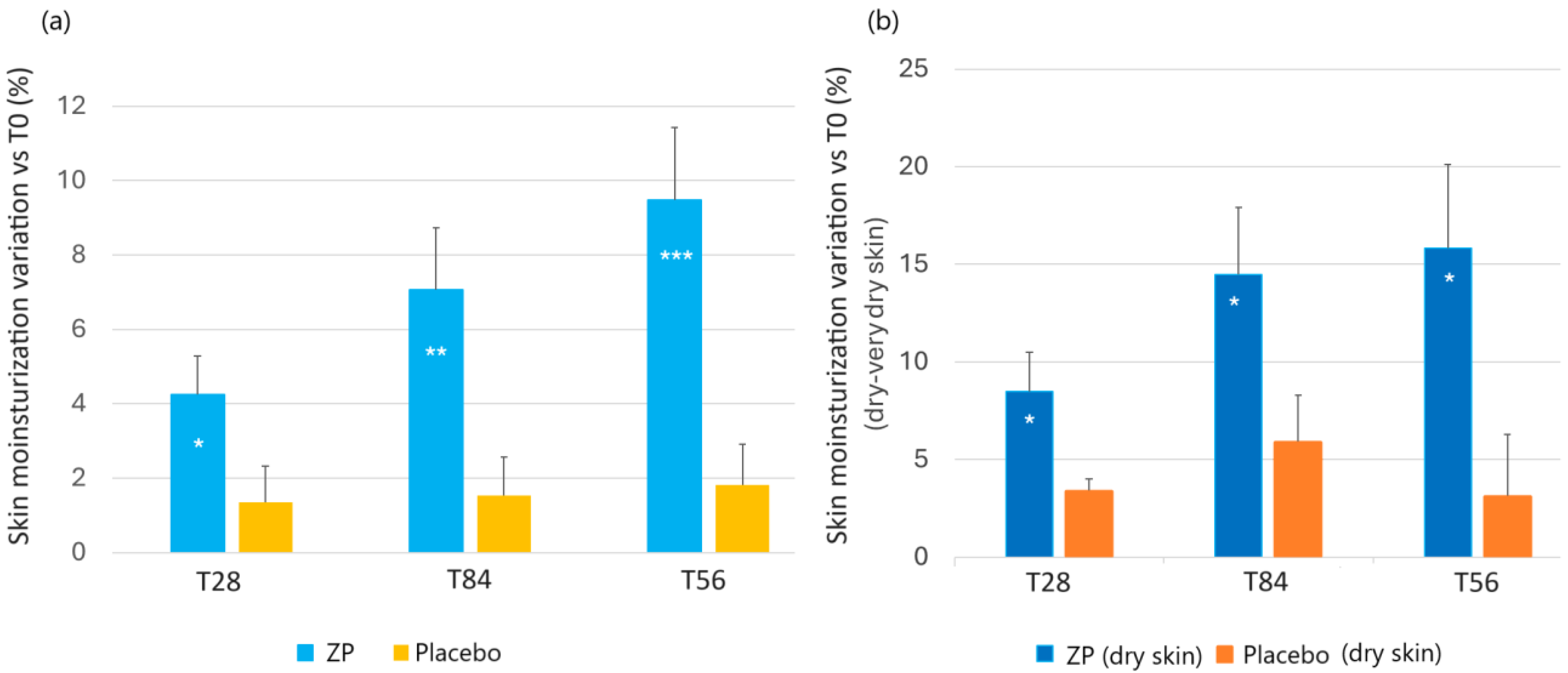
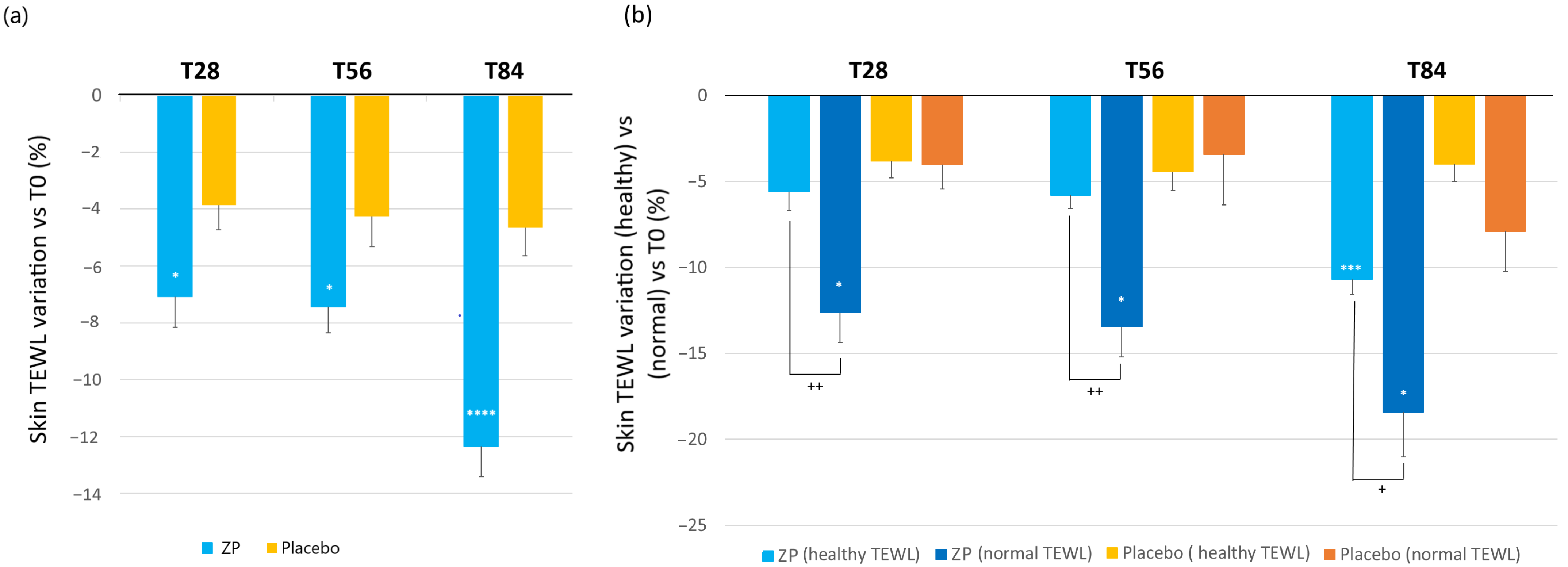
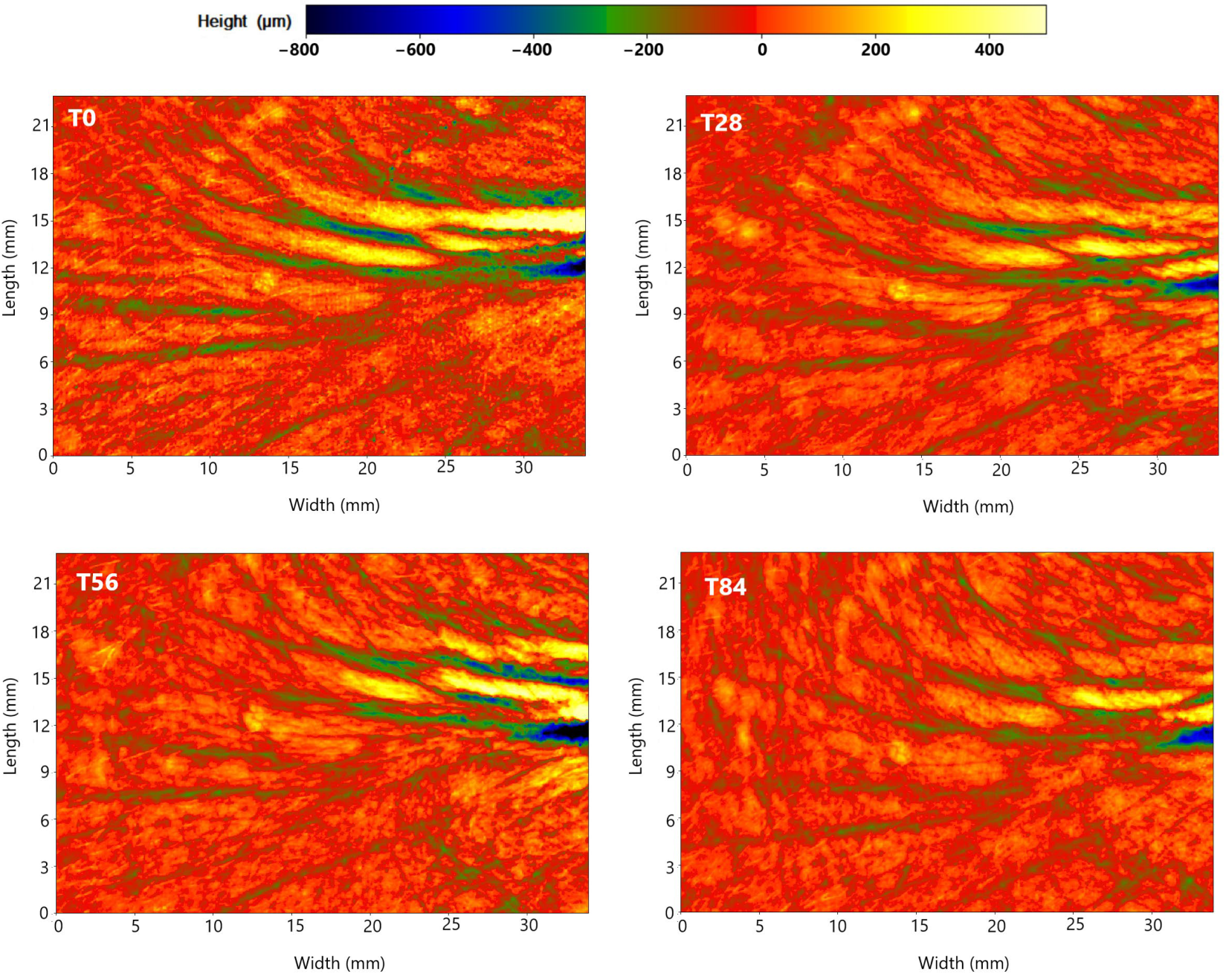
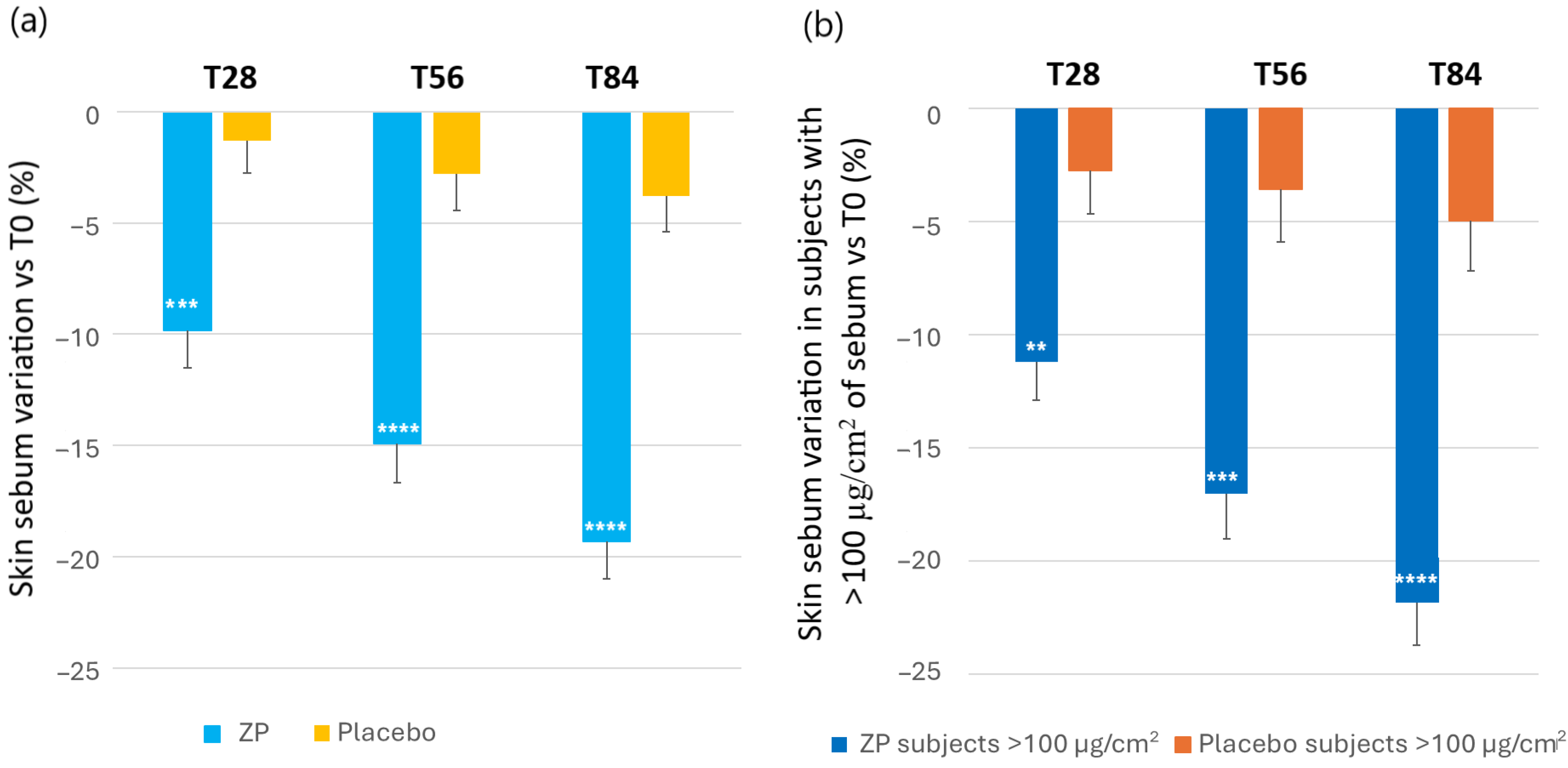

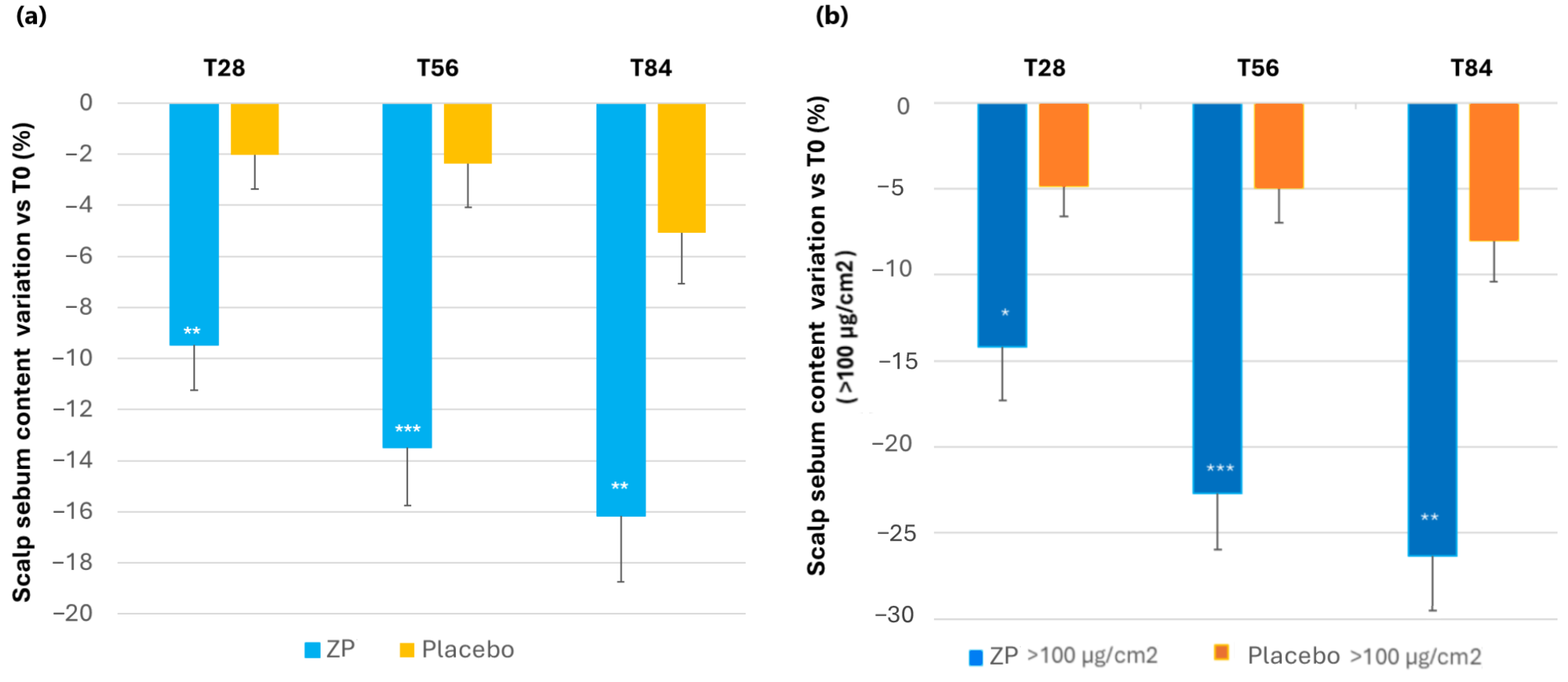
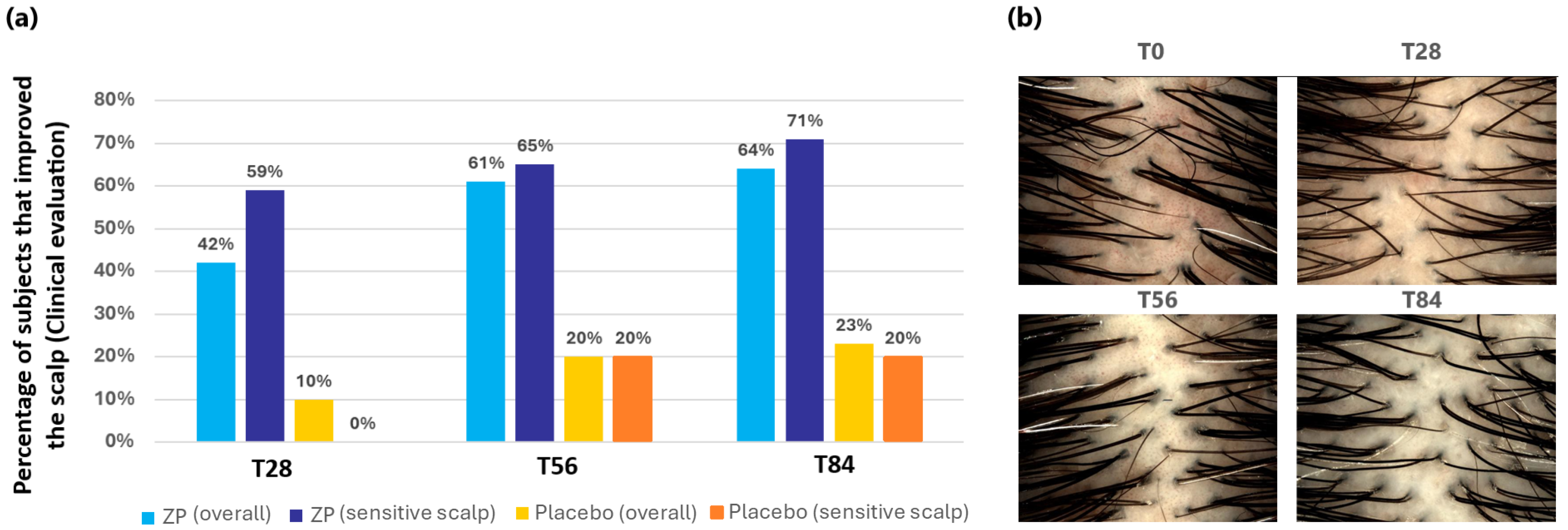
| Treatment Group | Placebo Group | |||||
|---|---|---|---|---|---|---|
| Overall (n = 33) | Sensitive (n = 17) | Not Sensitive (n = 16) | Overall (n = 33) | Sensitive (n = 15) | Not Sensitive (n = 15) | |
| Sex (Female) | 100% | 100% | ||||
| Age (years) | 52.4 ± 8.6 | 52.5 ± 7 | ||||
| Facial Skin Moisturization (c.u.) | 47.3 ± 1.85 | 44.12 ± 2.33 | 50.32 ± 2.68 | 49.69 ± 1.78 | 48.51 ± 2.99 | 50.86 ± 1.88 |
| TEWL (g × h−1 × m−2) | 13.04 ± 0.44 | 13.84 ± 0.55 | 13.24 ± 0.69 | 12.72 ± 0.39 | 13.13 ± 0.60 | 12.31 ± 0.46 |
| Sebum content (µg/cm2) | 129.7 ± 7.20 | 115.88 ± 7.65 | 144.56 ± 11.31 | 112.90 ± 9.0 | 118.93 ± 14.21 | 106.87 ± 10.84 |
| Wrinkle depth (µm) | 311.54 ± 21.84 | 351.85 ± 30.85 | 268.71 ± 27.06 | 260.82 ± 19.20 | 248.35 ± 28.49 | 273.29 ± 25.33 |
| R2 (Ua/Uf) | 0.625 ± 0.008 | 0.622 ± 0.009 | 0.627 ± 0.014 | 0.644 ± 0.009 | 0.641 ± 0.015 | 0.646 ± 0.009 |
| R0 (Uf) (mm) | 0.364 ± 0.008 | 0.373 ± 0.009 | 0.355± 0.012 | 0.365 ± 0.0064 | 0.367 ± 0.009 | 0.362 ± 0.008 |
| R5 (Ur/Ue) | 0.507 ± 0.018 | 0.503 ± 0.029 | 0.511 ± 0.018 | 0.534 ± 0.019 | 0.525 ± 0.025 | 0.542 ± 0.029 |
| ITA° (°) | 21.45 ± 0.84 | 20.95 ± 0.99 | 21.98 ± 1.36 | 22.59 ± 1.06 | 23.55 ± 1.51 | 21.63 ± 1.45 |
| Radiance (a.u.) | 11.05 ± 0.13 | 11.20 ± 0.20 | 10.89 ± 0.15 | 11.66 ± 0.29 | 11.64 ± 0.43 | 11.68 ± 0.39 |
| FRAP (Fe2+ µM) | 127.88 ± 9.71 | 117.16 ± 12.87 | 139.27 ± 14.10 | 136.04 ± 11.54 | 135.54 ± 16.44 | 136.53 ± 16.20 |
| Scalp Moisturization (µS) | 41.76 ± 2.27 | 43.65 ± 3.03 | 39.75 ± 3.33 | 42.60 ± 2.18 | 44 ± 3.21 | 41.20 ± 2.90 |
| TEWL (g × h−1 × m−2) | 15.32 ± 0.62 | 15.87 ± 0.87 | 14.72 ± 0.85 | 13.91 ± 0.61 | 15.15 ± 0.67 | 12.67 ± 0.91 |
| Sebum content (µg/cm2) | 83.24 ± 6.22 | 84.29 ± 7.62 | 82.13 ± 9.95 | 84.07 ± 7.03 | 79.93 ± 10.71 | 88.20 ± 8.98 |
| T0 | T28 | Δ at T28 | T56 | Δ at T56 | T84 | Δ at T84 | ||
|---|---|---|---|---|---|---|---|---|
| ACTIVE (ZP) | Wrinkle depth | 311.5 ± 22.2 | 284.8 ± 19.7 **** | −8.0% **** | 273.3 ± 20.5 **** | −12.5% **** | 258.1 ± 18.2 **** | −16.5% **** |
| R0 | 0.3644 ± 0.0078 | 0.3472 ± 0.0076 **** | −4.7·% *** | 0.3378 ± 0.0068 **** | −7.1% *** | 0.3289 ± 0.0066 **** | −9.4% *** | |
| R2 | 0.6245 ± 0.0085 | 0.6581 ± 0.0090 **** | 5.5% ** | 0.6682 ± 0.0096 **** | 7.2% ** | 0.6791 ± 0.0090 **** | 8.9% *** | |
| R5 | 0.5070 ± 0.0177 | 0.5324 ± 0.0179 **** | 5.3% *** | 0.5391 ± 0.0176 **** | 6.8% * | 0.5494 ± 0.0175 **** | 9.0% * | |
| ITA° | 21.4 ± 0.8 | 24.1 ± 0.8 **** | 13.1% *** | 25.6 ± 0.9 **** | 20.3% *** | 26.9 ± 1.0 **** | 26.5% *** | |
| Gloss | 11.05 ± 0.14 | 12.53 ± 0.17 **** | 13.6% **** | 13.45 ± 0.21 **** | 21.7% **** | 13.79 ± 0.24 **** | 24.9% **** | |
| PLACEBO | Wrinkle depth | 260.8 ± 19.5 | 262.8 ± 19.9 | −0.7% | 263.7 ± 20.1 | −1.0% | 257.2 ± 19.3 | −1.3% |
| R0 | 0.3646 ± 0.0065 | 0.3621 ± 0.0063 | −0.6% | 0.3549 ± 0.0064 * | −2.6% | 0.3489 ± 0.0064 **** | −4.3% | |
| R2 | 0.6438 ± 0.0089 | 0.6531 ± 0.0083 | 1.6% | 0.6639 ± 0.0091 *** | 3.2% | 0.6687 ± 0.0085 **** | 4.0% | |
| R5 | 0.5335 ± 0.0197 | 0.5365 ± 0.0191 | 0.8% | 0.5480 ± 0.0217 * | 2.5% | 0.5525 ± 0.0232 * | 3.1% | |
| ITA° | 22.6 ± 1.1 | 24.0 ± 1.2 **** | 5.9% | 25.0 ± 1.2 **** | 11.1% | 25.6 ± 1.1 **** | 14.2% | |
| Gloss | 11.66 ± 0.29 | 12.39 ± 0.29 **** | 6.5% | 12.41 ± 0.28 *** | 7.0% | 12.69 ± 0.30 **** | 9.3% |
| T0 | T28 | Δ at T28 | T56 | Δ at T56 | T84 | Δ at T84 | ||
|---|---|---|---|---|---|---|---|---|
| ACTIVE (ZP) | Moisturization | 41.8 ± 2.3 | 44.3 ± 2.4 **** | −6.4% *** | 45.7 ± 2.4 **** | −10.3% *** | 47.2 ± 2.5 **** | −14.1%**** |
| TEWL | 15.3 ± 0.6 | 14.1 ± 0.5 **** | −7.2·% * | 13.6 ± 0.5 **** | −10.1% ** | 13 ± 0.5 **** | −13.8% ** | |
| Sebum | 83.2 ± 6.2 | 74.5 ± 5.4 **** | −9.5% ** | 70.4 ± 5.0 **** | −13.5% *** | 68.0 ± 4.8 **** | −16.2% ** | |
| PLACEBO | Moisturization | 42.6 ± 2.2 | 43.0 ± 2.2 | −1.3% | 43.1 ± 2.2 | −1.6% | 43.2 ± 2.1 | −2.3% |
| TEWL | 13.9 ± 0.6 | 13.3 ± 0.6 *** | −3.7·% | 13.6 ± 0.6 *** | −4.7% | 12.9 ± 0.6 **** | −6.7% | |
| Sebum | 84.1 ± 7.2 | 81.7 ± 6.7 | −2.0% | 81.3 ± 6.8 | −2.4% | 78.5 ± 6.6 ** | −5.1% |
Disclaimer/Publisher’s Note: The statements, opinions and data contained in all publications are solely those of the individual author(s) and contributor(s) and not of MDPI and/or the editor(s). MDPI and/or the editor(s) disclaim responsibility for any injury to people or property resulting from any ideas, methods, instructions or products referred to in the content. |
© 2024 by the authors. Licensee MDPI, Basel, Switzerland. This article is an open access article distributed under the terms and conditions of the Creative Commons Attribution (CC BY) license (https://creativecommons.org/licenses/by/4.0/).
Share and Cite
Nobile, V.; Cestone, E.; Ghirlanda, S.; Poggi, A.; Navarro, P.; García, A.; Jones, J.; Caturla, N. Skin and Scalp Health Benefits of a Specific Botanical Extract Blend: Results from a Double-Blind Placebo-Controlled Study in Urban Outdoor Workers. Cosmetics 2024, 11, 139. https://doi.org/10.3390/cosmetics11040139
Nobile V, Cestone E, Ghirlanda S, Poggi A, Navarro P, García A, Jones J, Caturla N. Skin and Scalp Health Benefits of a Specific Botanical Extract Blend: Results from a Double-Blind Placebo-Controlled Study in Urban Outdoor Workers. Cosmetics. 2024; 11(4):139. https://doi.org/10.3390/cosmetics11040139
Chicago/Turabian StyleNobile, Vincenzo, Enza Cestone, Sabrina Ghirlanda, Andrea Poggi, Pau Navarro, Adrián García, Jonathan Jones, and Nuria Caturla. 2024. "Skin and Scalp Health Benefits of a Specific Botanical Extract Blend: Results from a Double-Blind Placebo-Controlled Study in Urban Outdoor Workers" Cosmetics 11, no. 4: 139. https://doi.org/10.3390/cosmetics11040139
APA StyleNobile, V., Cestone, E., Ghirlanda, S., Poggi, A., Navarro, P., García, A., Jones, J., & Caturla, N. (2024). Skin and Scalp Health Benefits of a Specific Botanical Extract Blend: Results from a Double-Blind Placebo-Controlled Study in Urban Outdoor Workers. Cosmetics, 11(4), 139. https://doi.org/10.3390/cosmetics11040139







